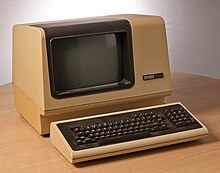VT100
VT100 is a ASCII - computer terminal , manufactured by Digital Equipment Corporation (DEC) in the years 1978 bis 1983 .
One of the first computer terminals has ANSI - escape sequences to control the cursor supports and other objects, and it led about one to a number of other codes LED to control the keyboard. Due to the widespread use of the VT100, its successors and imitators, the escape sequences became the de facto standard for terminal emulation (VT100 / 102 standard).
The VT100 series, especially the VT102, were so successful that DEC became the market leader for computer terminals. The successor series VT200 , which DEC manufactured from 1983 onwards, was also very successful, so that DEC was able to record cumulative sales of more than 6 million units.
function
The VT100 terminal could display 24 lines of 80 US-ASCII characters or alternatively 14 lines of 132 characters on its 30 cm (12 inch) monochrome screen. The output of character-oriented graphics (semi-graphics), inverse, flashing or enlarged text was made possible by ANSI escape sequences . It had an extended typewriter keyboard (83 keys, QWERTY assignment) with a few function keys. It was connected to the host computer via one of its serial interfaces (EIA-232 ( RS-232 ) or, optionally, a 20 mA teleprinter connection) . This picture tube terminal was widely used on DEC mainframes (mainframes: DECsystem 10, DECsystem 20 and VAX 11) as well as DEC computers of the minicomputer class ( PDP-11 ) under the DEC multi-user operating systems such as RSX-11 and VMS .
The VT100 was a low-cost product and replaced the electromechanical DEC teleprinter “Teletype” ( ASR-33 and LA36) and the older terminal VT52 and was in turn replaced by the VT200 series. The ESCAPE control code set and the (data flow) control commands of the US-ASCII character set (96 characters) defined much earlier were a de facto standard supported by a large number of devices from different manufacturers ( VT100 mode).
From 1982, under the name VT180 a special version of the VT100 with additional built- Z80 - map available. This device could be used either as a terminal or as a computer with the CP / M operating system .
From 1983 the successor models of the VT200 series were delivered.
Screen control
The VT100 terminal also refers to the screen control of the VT100 terminal using escape sequences based on ANSI standards. Instead of letters and numbers to be displayed, defined character strings are sent to the terminal as control instructions that begin with the character " Escape " (ASCII decimal 27, hexadecimal 1B). For example, the screen with the string ESC[2Jdeleted, the cursor with ESC[0;0Hon line 0, column 0 positioned the character attribute ESC[7m(dark bright background, foreground) to inverse and ESC[0mswitched back etc. Other screen producers have launched their own products on the market, in the same way worked (VT100 emulation ). Subsequently , software ( terminal emulation ) that simulates the VT100 functions was increasingly used on microcomputers , especially personal computers (PCs) . Due to the inexpensive, multifunctional use of PCs as terminals, independent terminals have become increasingly dispensable.
The VT-100 control was a quasi-standard for several years and was supported by numerous terminal manufacturers (including Tandberg Data , TeleVideo , Wyse Technology ). Conventional terminal software VT100 also emulates, e.g. B. the freeware Tera Term .
Individual evidence
- ↑ VT 510/520 Video Display Terminal. Boundless Technologies
- ↑ VT100 technical specification. In: vt100.net , page 21
- ↑ VT100 keyboard. In: vt100.net , page 24
- ↑ VT100 User Guide, Programmer Information. In: vt100.net
- ↑ Brief overview of VT100 escape sequences. In: ascii-table.com

